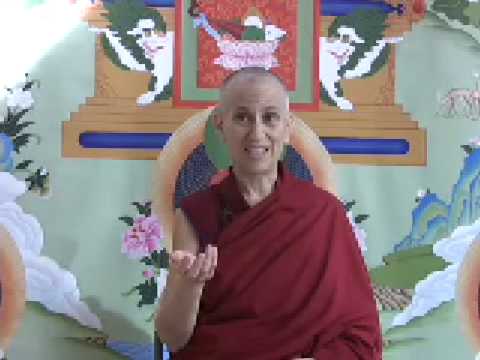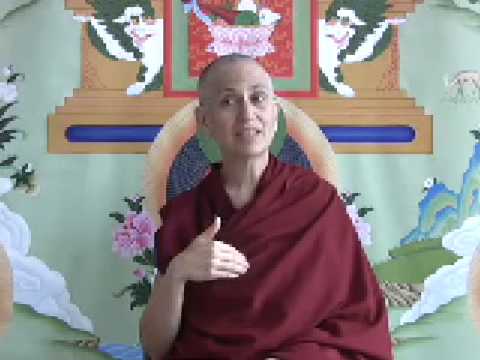Emptiness and the object of negation, part 1
The first of three talks on emptiness and the object of negation for the Bodhisattva's Breakfast Corner.
A little while ago we were talking about emptiness and being able to identify the object of negation by noticing when it’s not there, or being able to identify the self-grasping by noticing when it’s not there. And I was saying that the object of negation is always appearing to our senses for us normal, average beings who have not had direct realization of emptiness, but the grasping at inherent existence isn’t always manifest in our mind.
Remember, inherent existence is appearing to us all the time, but we have a hard time identifying what the appearance of inherent existence is, and without identifying what inherent existence is, we can’t negate it. So, one way to ask yourself if the object that is appearing to us is inherently existent or not is to take away whatever is appearing to your mind and ask yourself if there is something still there that is the object.
We look over here and we say, “Chair.” We just say “chair” because something is appearing to our mind. Actually, what’s happening is that there is some basis appearing to our mind and we’re labeling it “chair.” Now take away what is appearing to our mind, and is there a chair there that exists from its own side? It seems like there should be. When we look at something it seems as if it has its own essence within it, that there’s something that makes it it. It doesn’t just seem as if it’s an appearance to the mind. It seems like a real object. To understand what inherent existence is, take away what’s appearing to your mind, and what’s left should be the inherent existence that that object actually has—if it is inherently existent.
We’ll just use a person as an example. Apart from what appears to you, what is the person? If we look at Diane, apart from what appears to us, what is Diane? It doesn’t seem like Diane is just an appearance to us, it seems like there is a real person there. But apart from what is appearing, what is she?
And we can do that for ourselves, too, because we label myself apart from what is appearing to be me to us. What am I? Because it seems that there should be something there apart from what it appears. Because we’re not just appearances, or so it seems. We’re something real! So, you should be able to take away the appearance, and that’s the inherent existence.
But it’s very difficult in our perception. That’s why when you have a strong emotion and a grasping at inherent existence is manifest that it’s easier to identify the object of negation. Because when you look at something at that time, it really, really appears as if it has inherent existence in it. So, you then have the feeling that if you took away the appearance, you would find something that was there, because at that time it really does feel like there is something there. That’s why it’s helpful to look at the situation when there is a strong emotion, a strong affliction arising in the mind—not a strong virtuous emotion because you’re not necessarily grasping at inherent existence at that time. But with a strong negative emotion you definitely do want to look
Apart from what appears to you, what is the person? Is there an essence that exists beyond that appearance? It seems like there is. Especially when you are really attached to someone, it seems like there is the essence of that person. Take some relative or some friend that you’re so attached to, and it feels like there is some essence to them that makes it why you are attached to them. We were talking the other day about how it seems there is some good quality in them because you don’t get attracted to just everybody. There’s something in them that makes you attracted to them, something existing from their own side that makes you attracted to them.
When that seems very strong like that, then take away the appearance of that person and you should be able to find what the essence is that is beyond what is appearing to you. You should be able to find what is that person, or that is that good quality.
If you take away what appears, what is left? Because before you take away what appears, it seems like there is more there than what appears. In fact, you don’t even think that what appears is something appearing; you think that it is it! [laughter] Don’t you? You don’t even think that there’s an essence and an appearance that are mixed together. We don’t think that. It is it. But then just take away the appearance, and what is it? What’s left? Because that’s what you’re grasping as existing.
Questions & Answers
Audience: Sense consciousness gives appearances and mental consciousness gives appearances, too, so then what would you search for? Or what is beyond these things? What’s left?
Venerable Chodron (VTC): Yes, the appearances come to both the mental consciousness and the sense consciousness.
Audience: What would you sense?
VTC: Oh, you mean with your eyes?
Audience: No, I mean if you cast aside the mental consciousness and the five sense consciousnesses, then what is left?
VTC: We’re not saying take away the consciousness that’s apprehending. We’re saying take away what’s appearing to that consciousness.
Audience: So, all consciousnesses give appearances?
VTC: All consciousnesses have appearances, yes.
Audience: It is as if you could use reasoning.
VTC: Yes, that’s true. We are using reasoning, because to take away the appearance, we can’t take that away physically. We’re mentally examining and analyzing. If I took away what was appearing to me, what would be there?
Audience: But with what would you sense it?
VTC: Well, if there was actually something there, then your consciousnesses should be able to see it. That’s what inherent existence is: something that is really there. So, if things really had an essence, your consciousnesses should be able to both sense that and apprehend it even after you took away the appearance. But this is done through reasoning, through the mental consciousness.
Audience: I think it’s the definition of appearance. What apart from the experience that is the object?
VTC: It’s not so much experience, because experience is in here, within us, but it’s just what’s appearing. That’s a good question because we don’t normally analyze what is appearing to our mind. We just take the appearances as being the object. So, to even figure out what we’re going to take away is hard, isn’t it?
Venerable Thubten Chodron
Venerable Chodron emphasizes the practical application of Buddha’s teachings in our daily lives and is especially skilled at explaining them in ways easily understood and practiced by Westerners. She is well known for her warm, humorous, and lucid teachings. She was ordained as a Buddhist nun in 1977 by Kyabje Ling Rinpoche in Dharamsala, India, and in 1986 she received bhikshuni (full) ordination in Taiwan. Read her full bio.


